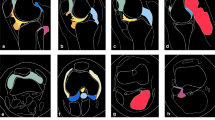Abstract
Objective
To determine the frequency with which MRI of tenosynovial giant cell tumor demonstrates hemosiderin, visible intralesional fat signal, and proximity to synovial tissue.
Material and methods
This is a retrospective study of 31 cases of tenosynovial giant cell tumors which had concomitant MRI. Images were examined for lesion size, morphology, origin, bone erosions, MRI signal characteristics, contrast enhancement, and blooming artifact, comparing prospective and retrospective reports. Histology was reviewed for the presence of hemosiderin and xanthoma cells.
Results
Eight lesions were diffuse and 23 were localized nodules. Three lesions were located in subcutaneous tissue and 4 adjacent to tendons beyond the extent of their tendon sheath. All lesions exhibited areas of low T1- and T2-weighted signal. Blooming artifact on gradient echo imaging was present in 86% of diffuse and only 27% of nodular disease. There was interobserver variability of 40% in assessing blooming. Iron was visible on H&E or iron stain in 97% of cases. Fat signal intensity was seen in only 3% of cases, although xanthoma cells were present on in 48%. The correct diagnosis was included in the prospective radiology differential diagnosis in 86% of diffuse cases and 62% of nodular cases.
Conclusion
Blooming on GRE MRI has low sensitivity for nodular tenosynovial giant cell tumors and is not universal in diffuse tumors. There was high interobserver variability in assessment of blooming. Intralesional fat signal is not a useful sign and may occur adjacent to tendons which lack a tendon sheath and may occur in a subcutaneous location.




Similar content being viewed by others
References
Jaffe HLLL, Sutro CJ. Pigmented villonodular synovitis, bursitis, and tenosynovitis: A discussion of synovial and bursal equivalents of the tenosynovial lesion commonly denoted as xanthoma, xanthogranuloma, giant cell tumor or myeloplaxoma of the tendon sheath. Archives of Pathology. 1943;31:731–65.
De Saint Aubi Somerhausen N vRM. Tenosynovial giant cell tumor. In: Board WCTE, editor. Soft Tissue and Bone Tumours. 5th ed. Lyon: International Agency for Research on Cancer; 2020.
Murphey MD, Rhee JH, Lewis RB, Fanburg-Smith JC, Flemming DJ, Walker EA. Pigmented villonodular synovitis: radiologic-pathologic correlation. Radiographics. 2008;28(5):1493–518.
Goldblum JR, Folpe ALWS. Benign tumors and tumor-like lesions of synovial tissue. In: Enzinger and Weiss’s soft tissue tumors, 7th ed. Philadelphia: Elsevier; 2019. p. 864–74.
Capelastegui A, Astigarraga E, Fernandez-Canton G, Saralegui I, Larena JA, Merino A. Masses and pseudomasses of the hand and wrist: MR findings in 134 cases. Skeletal Radiol. 1999;28(9):498–507.
Jelinek JS, Kransdorf MJ, Utz JA, Berrey BH Jr, Thomson JD, Heekin RD, et al. Imaging of pigmented villonodular synovitis with emphasis on MR imaging. AJR Am J Roentgenol. 1989;152(2):337–42.
Hughes TH, Sartoris DJ, Schweitzer ME, Resnick DL. Pigmented villonodular synovitis: MRI characteristics. Skeletal Radiol. 1995;24(1):7–12.
Cheng XG, You YH, Liu W, Zhao T, Qu H. MRI features of pigmented villonodular synovitis (PVNS). Clin Rheumatol. 2004;23(1):31–4.
Llauger J, Palmer J, Roson N, Cremades R, Bague S. Pigmented villonodular synovitis and giant cell tumors of the tendon sheath: radiologic and pathologic features. AJR Am J Roentgenol. 1999;172(4):1087–91.
Blacksin MF, Ha DH, Hameed M, Aisner S. Superficial soft-tissue masses of the extremities. Radiographics. 2006;26(5):1289–304.
Girish G, Glazebrook KN, Jacobson JA. Advanced imaging in gout. AJR Am J Roentgenol. 2013;201(3):515–25.
Somerhausen NS, Fletcher CD. Diffuse-type giant cell tumor: clinicopathologic and immunohistochemical analysis of 50 cases with extraarticular disease. Am J Surg Pathol. 2000;24(4):479–92.
Myers BW, Masi AT. Pigmented villonodular synovitis and tenosynovitis: a clinical epidemiologic study of 166 cases and literature review. Medicine (Baltimore). 1980;59(3):223–38.
Ushijima M, Hashimoto H, Tsuneyoshi M, Enjoji M. Giant cell tumor of the tendon sheath (nodular tenosynovitis). A study of 207 cases to compare the large joint group with the common digit group. Cancer. 1986;57(4):875–84.
Clavero JA, Golano P, Farinas O, Alomar X, Monill JM, Esplugas M. Extensor mechanism of the fingers: MR imaging-anatomic correlation. Radiographics. 2003;23(3):593–611.
Wood JF. In: Bailliere TC, editor. The Principles of Anatomy as Seen in the Hand. 2nd ed; 1946.
De Beuckeleer L, De Schepper A, De Belder F, Van Goethem J, Marques MC, Broeckx J, et al. Magnetic resonance imaging of localized giant cell tumour of the tendon sheath (MRI of localized GCTTS). Eur Radiol. 1997;7(2):198–201.
Cevik HB, Kayahan S, Eceviz E, Gumustas SA. Tenosynovial giant cell tumor in the hand: Experience with 173 cases. J Hand Surg Asian Pac Vol. 2020;25(2):158–63.
Sanghvi DA, Purandare NC, Jambhekar NA, Agarwal MG, Agarwal A. Diffuse-type giant cell tumor of the subcutaneous thigh. Skeletal Radiol. 2007;36(4):327–30.
Lee YJ, Kang Y, Jung J, Kim S, Kim CH. Intramuscular tenosynovial giant cell tumor, diffuse-type. J Pathol Transl Med. 2016;50(4):306–8.
Bravo SM, Winalski CS, Weissman BN. Pigmented villonodular synovitis. Radiol Clin North Am. 1996;34(2):311–26 x-xi.
Author information
Authors and Affiliations
Corresponding author
Ethics declarations
Conflicts of interest
The authors declare that they have no conflict of interest to report.
Additional information
Publisher’s note
Springer Nature remains neutral with regard to jurisdictional claims in published maps and institutional affiliations.
Rights and permissions
About this article
Cite this article
Crim, J., Dyroff, S.L., Stensby, J.D. et al. Limited usefulness of classic MR findings in the diagnosis of tenosynovial giant cell tumor. Skeletal Radiol 50, 1585–1591 (2021). https://doi.org/10.1007/s00256-020-03694-4
Received:
Revised:
Accepted:
Published:
Issue Date:
DOI: https://doi.org/10.1007/s00256-020-03694-4




